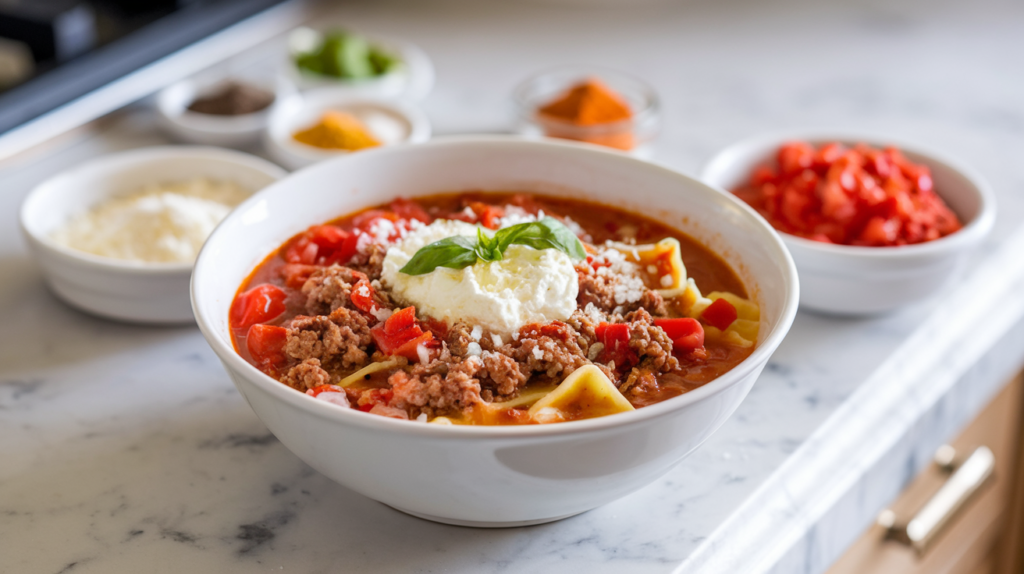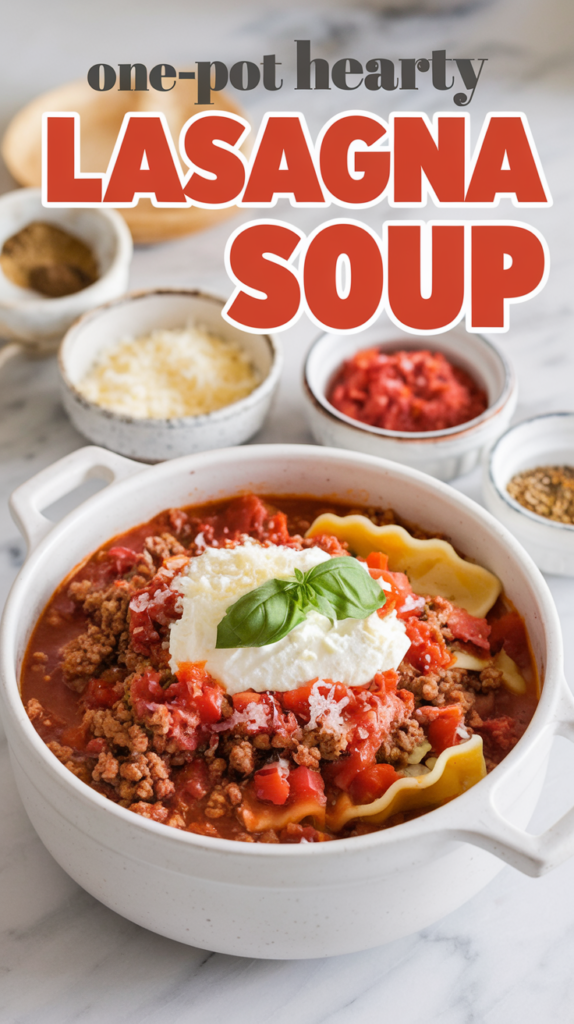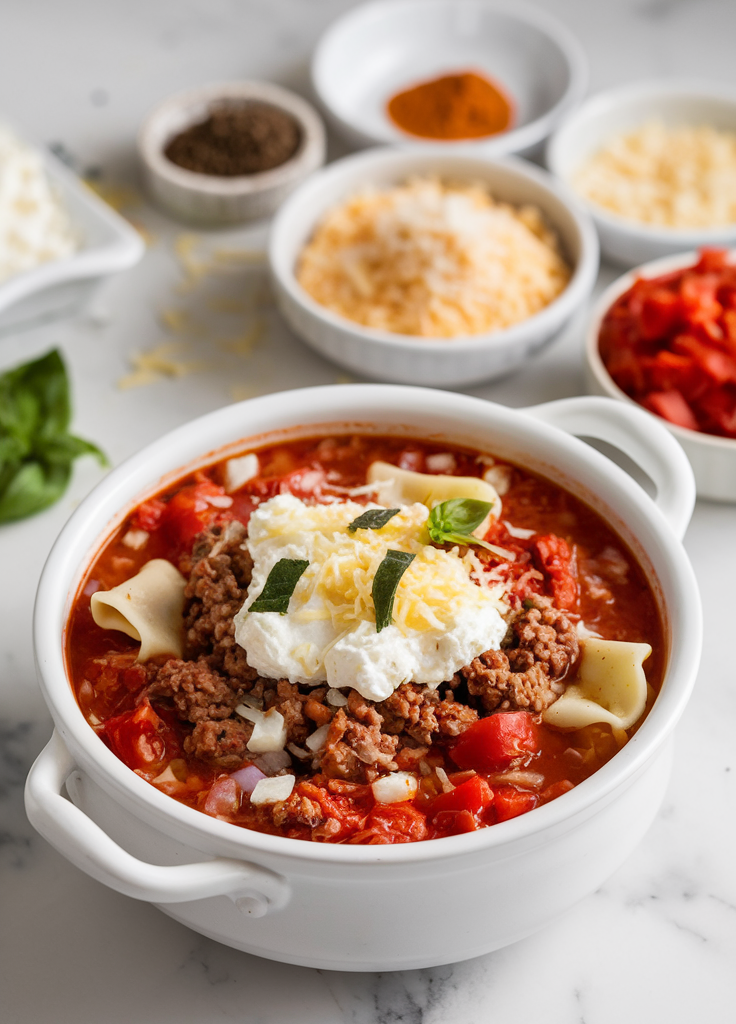Lasagna is one of those classic comfort foods that never fails to satisfy, but what if you could take all those hearty, cheesy, savory flavors and enjoy them in a more approachable, time-efficient way?
Enter lasagna soup – a delightful, cozy twist on the traditional baked dish that has all the deliciousness of lasagna but in a bowl.

It’s a rich, tomato-based broth filled with all the iconic elements of lasagna: tender noodles, flavorful meat, fragrant herbs, and a medley of melty cheeses that stretch and pull with each spoonful.
This recipe is perfect for those days when you’re craving lasagna but don’t have the time or energy to layer ingredients and wait for a casserole to bake. Lasagna soup is quick, easy, and comes together in just one pot, making it an ideal meal for busy weeknights, family dinners, or even casual get-togethers with friends. You get the warmth of a hearty soup paired with the richness of lasagna – all in less time and with less cleanup.

It’s a win-win for anyone who loves Italian flavors but doesn’t want the hassle of preparing a traditional lasagna!
It’s also incredibly versatile – you can customize the ingredients to suit your dietary preferences, whether you’re looking for a meatless option or a low-carb version.
P.S. In a rush? Click the “Jump to Recipe” button to get straight to the recipe.
In this post, you'll find...
Ingredients List
Here’s a detailed list of ingredients you’ll need for the Lasagna Soup Recipe, along with their measurements:
- 1 lb ground beef (or ground turkey, chicken, or plant-based alternative)
- 1/2 lb Italian sausage (optional for extra flavor, can be spicy or mild)
- 1 medium onion, diced
- 4 cloves garlic, minced
- 4 cups beef broth (or vegetable broth for a lighter or vegetarian option)
- 1 can (28 oz) crushed tomatoes
- 2 tablespoons tomato paste
- 1 1/2 teaspoons dried basil
- 1 teaspoon dried oregano
- 1/2 teaspoon dried thyme
- 1/2 teaspoon red pepper flakes (optional for heat)
- 8 oz lasagna noodles, broken into bite-sized pieces (or substitute with other pasta like fusilli or penne)
- 1 cup ricotta cheese
- 1 1/2 cups shredded mozzarella cheese
- 1/2 cup grated parmesan cheese
- Salt and pepper to taste
- Fresh basil or parsley, chopped (optional, for garnish)
- Spinach or kale, a handful (optional, for added nutrition)
The Importance of Each Ingredient
Before diving into the step-by-step instructions, let’s take a closer look at the key ingredients that make this lasagna soup irresistible. Each component plays a crucial role in delivering the comforting flavors of traditional lasagna in a more simplified, soup form.
Meat & Protein
The foundation of this lasagna soup starts with a hearty combination of ground beef and Italian sausage. The ground beef provides a classic, robust flavor, while the Italian sausage adds extra seasoning and depth with its mix of spices like fennel and garlic.
If you’re looking to lighten up the recipe, you can substitute the ground beef with ground turkey or chicken. These options provide a leaner alternative without compromising the overall taste. For a vegetarian twist, consider using plant-based crumbles or more vegetables to maintain that savory texture.
- Ground Beef: The classic choice for lasagna, offering a meaty, rich flavor.
- Italian Sausage: Adds a burst of seasoning and a hint of spice. You can use either mild or spicy sausage, depending on your preference.
- Substitutes: Ground turkey, chicken, or plant-based meat alternatives for a lighter or vegetarian version.
Broth & Liquid Base
The base of the soup is what brings all the flavors together. Using beef broth creates a deep, rich backdrop for the tomato sauce, enhancing the overall heartiness of the dish. If you prefer a lighter soup or a vegetarian option, vegetable broth is an excellent alternative.
In addition to broth, crushed tomatoes and tomato paste form the backbone of the lasagna flavor. Crushed tomatoes offer a fresh, slightly sweet tomato taste, while tomato paste adds a concentrated, deep tomato flavor that thickens the soup and intensifies the richness.
- Beef Broth: Provides a savory, full-bodied base for the soup.
- Crushed Tomatoes: These give the soup a fresh, tomato-rich flavor without being too overpowering.
- Tomato Paste: Adds depth and thickens the broth, giving it that rich lasagna sauce consistency.
- Substitutes: Vegetable broth for a lighter or vegetarian option.
Pasta
Lasagna wouldn’t be lasagna without pasta, and in this soup version, we use broken lasagna noodles to mimic the layers of the traditional dish. These large, flat noodles give the soup the same texture and experience as eating lasagna, but without all the assembly.
To make it easier to eat, you’ll break the lasagna noodles into bite-sized pieces. If you don’t have lasagna noodles on hand or prefer something different, feel free to substitute with other types of pasta like fusilli, rotini, or penne. The key is to choose a pasta shape that will hold up well in the soup and provide a satisfying bite.
- Broken Lasagna Noodles: These mimic the layers of a traditional lasagna, giving the soup its signature texture.
- Substitutes: Short pasta shapes like fusilli, penne, or even bow-tie pasta can be used as alternatives.
Vegetables & Aromatics
Aromatic vegetables like onion and garlic are sautéed to create a flavorful base for the soup. These ingredients infuse the broth with a rich, savory aroma, laying the foundation for the soup’s depth of flavor.
In addition to the aromatics, Italian herbs like dried basil and oregano bring that unmistakable lasagna taste to life. If you like a little more freshness, you can add fresh basil or parsley at the end for a burst of color and brightness.
For extra nutrition and color, consider adding spinach or kale. These greens not only boost the health factor but also complement the rich tomato base perfectly. They wilt into the soup just before serving, providing a subtle yet nutritious addition.
- Onion & Garlic: Essential aromatics that build the flavor base of the soup.
- Italian Herbs (Dried Basil, Oregano, Thyme): Give the soup its classic Italian flavor.
- Optional Vegetables: Spinach or kale for added nutrients and a pop of green.
Cheeses
Lasagna is nothing without its gooey, melty cheese, and this soup is no exception. To replicate the creamy, cheesy layers of lasagna, you’ll use a combination of ricotta, mozzarella, and parmesan.
- Ricotta Cheese: This soft cheese adds a creamy, slightly sweet element to the soup. Stirring a spoonful into the broth gives it a luxurious texture that mimics the creamy layers of traditional lasagna.
- Mozzarella Cheese: Known for its gooey, melty goodness, mozzarella is sprinkled on top or stirred into the soup for that iconic lasagna stretch with every bite.
- Parmesan Cheese: Adds a salty, nutty flavor that complements the richness of the tomato broth. It’s often used as a final garnish for a sharp finish.
These cheeses melt beautifully into the soup, giving it a rich, indulgent taste. You can mix them directly into the soup or serve them on top as a garnish, letting them melt over the hot broth as you serve.
Seasonings
No lasagna soup would be complete without a touch of seasoning to bring all the flavors together. Besides the salt and pepper to taste, adding red pepper flakes gives the soup a subtle heat. If you prefer a bit of spice, feel free to add extra, but it’s also completely optional for those who prefer a milder taste.
- Salt & Pepper: Essential for seasoning the broth and bringing out the natural flavors of the ingredients.
- Red Pepper Flakes: Optional, but they add a slight kick of heat to balance the rich, creamy flavors.
How to Make Lasagna Soup
Now that you’ve gathered all your ingredients, it’s time to bring this delicious lasagna soup to life! The following step-by-step instructions will guide you through the process, ensuring that each layer of flavor builds into a rich, comforting bowl of soup.
Step 1: Preparing the Base
The base of the soup is where the magic begins, and it all starts with browning the meat. Heat a large, heavy-bottomed pot over medium-high heat. Begin by adding the ground beef and Italian sausage to the pot. Break up the meat with a spoon or spatula, ensuring that it cooks evenly. As the meat browns, you’ll notice flavorful bits beginning to form at the bottom of the pot — these will enhance the soup’s overall taste.
- Tip: For a leaner soup, you can drain any excess fat from the meat once it has browned. However, leaving a small amount of fat in the pot can add to the richness of the soup.
Once the meat is browned and fully cooked, transfer it to a plate using a slotted spoon. Leave a little fat in the pot for the next step — sautéing the aromatics.
In the same pot, add the diced onions. Cook for about 4-5 minutes, stirring occasionally, until they become soft and translucent. Then, add the minced garlic and sauté for another 30 seconds to a minute, just until the garlic becomes fragrant. You want to avoid burning the garlic, as it can turn bitter.
Step 2: Building the Soup
Once your onions and garlic are soft and aromatic, it’s time to bring in the bold tomato flavors. Stir in the tomato paste, letting it cook for a minute or two. This step deepens the tomato flavor and allows the paste to caramelize slightly, enhancing the richness of the soup.
After the tomato paste has been cooked through, add the crushed tomatoes and broth (beef or vegetable) to the pot. Stir everything together to combine the flavors.
- Tip: If you prefer a slightly thinner or more broth-based soup, you can add an additional cup of broth at this stage.
Now, season the soup with dried basil, oregano, thyme, and red pepper flakes (if you like a little heat). Season with salt and pepper to taste. Bring the mixture to a simmer and allow it to cook for 10-15 minutes, letting all the flavors meld together.
Optional: At this point, if you’re adding extra veggies like spinach or kale, stir them in and let them wilt down as the soup simmers. This adds a nutritional boost and vibrant color to the soup.
Step 3: Cooking the Pasta
The key to a good lasagna soup is the pasta — after all, lasagna wouldn’t be lasagna without those signature noodles! Take your lasagna noodles and break them into bite-sized pieces. This not only makes the soup easier to eat, but it also mimics the layered texture of traditional lasagna.
You have two options when it comes to cooking the pasta:
Option 1: Cook Directly in the Soup
Stir the broken lasagna noodles directly into the simmering soup. This method allows the pasta to absorb all the rich flavors of the broth as it cooks. Stir occasionally to prevent the noodles from sticking to the bottom of the pot. Cook for about 8-10 minutes, or until the pasta is al dente.
Tip: Keep an eye on the soup’s consistency as the pasta cooks. The noodles will absorb some of the liquid, so you may want to add a bit more broth if it gets too thick.
Option 2: Cook Separately
If you prefer your pasta to have a firmer texture, cook the lasagna noodles separately in a pot of salted boiling water according to the package instructions. Drain the noodles and stir them into the soup just before serving. This method prevents the noodles from overcooking or becoming too soft if you plan on making the soup ahead of time or freezing it.
Step 4: Adding Cheese
One of the hallmarks of lasagna is the cheese, and this soup version doesn’t shy away from it. The cheese is what transforms the soup from a simple tomato-based broth into a creamy, decadent bowl of comfort.
- Ricotta: Stir in about a cup of ricotta cheese into the soup during the final few minutes of cooking. This will give the broth a creamy texture and add a slight sweetness that balances the acidity of the tomatoes.
- Mozzarella & Parmesan: You have a couple of options here. You can either stir the mozzarella and parmesan directly into the soup, allowing them to melt into the broth, or you can serve them as a topping. Sprinkling shredded mozzarella and grated parmesan on top of each bowl gives you that classic lasagna cheesiness that stretches with every spoonful.
Tip: For an extra indulgent finish, pop each bowl under the broiler for a minute or two to melt and brown the mozzarella topping.
Step 5: Optional Garnishes
Now that your lasagna soup is ready, it’s time to finish it off with some garnishes to brighten the flavors and add visual appeal. Consider topping each bowl with:
- Fresh basil or parsley: Chopped fresh herbs give the soup a burst of freshness and a pop of color.
- Extra parmesan: A final sprinkle of grated parmesan cheese adds an extra layer of salty, nutty flavor.
- Red pepper flakes: If you enjoy a bit of heat, a dash of red pepper flakes on top can enhance the overall spiciness of the soup.
Substitutions and Customizations
One of the best things about lasagna soup is its versatility. While the basic recipe is already a crowd-pleaser, you can easily adapt it to suit various dietary needs, preferences, or simply to switch things up for a different flavor experience.
Below are some ideas to help you make this soup truly your own, whether you’re looking for a meatless version, a low-carb option, or simply want to enhance its richness.
Vegetarian/Vegan Adaptations
If you’re following a vegetarian or vegan diet, there’s no need to miss out on the deliciousness of lasagna soup. With a few simple swaps, you can enjoy a plant-based version that’s just as hearty and flavorful as the original.
- Substitute the Meat: Instead of using ground beef and sausage, you can add extra vegetables or plant-based meat crumbles to maintain the meaty texture. Vegetables like mushrooms, zucchini, and eggplant work well because they provide a similar savory depth and heartiness. Mushrooms, in particular, have an umami quality that makes them an excellent meat substitute.
- Tip: Use a mix of baby bella or portobello mushrooms for the best results, as they have a meatier texture.
- Use Vegetable Broth: Swap out the beef broth for vegetable broth. This keeps the base of the soup just as flavorful but makes it completely plant-based.
- Vegan Cheese Substitutes: For the cheesy element, opt for dairy-free alternatives. Many grocery stores now offer vegan ricotta, mozzarella, and parmesan that melt beautifully into soups. You can also make your own vegan “ricotta” by blending tofu with a bit of nutritional yeast, lemon juice, and salt.
- Tip: Nutritional yeast is a great addition to vegan recipes, as it has a cheesy, nutty flavor that mimics parmesan. Sprinkle a little over the soup for an extra boost of flavor.
Low-Carb/Keto Version
If you’re following a low-carb or ketogenic diet, you can still enjoy the flavors of lasagna without the traditional noodles. By making a few modifications, you can create a low-carb version that fits perfectly into your dietary goals.
- Replace the Pasta: Instead of using traditional lasagna noodles, which are high in carbs, try using zucchini noodles (zoodles) or spiralized yellow squash. These low-carb alternatives add a tender texture to the soup without the carbs from regular pasta. You can also use spaghetti squash, which can be roasted and shredded to resemble pasta strands.
- Tip: Another option is cauliflower, which can be added in small florets or riced for a hearty, low-carb addition to the soup. Cauliflower absorbs the soup’s flavors beautifully and adds bulk without carbs.
- Creamier Base: To make the soup richer and more filling for those on a ketogenic diet, you can add a splash of heavy cream or cream cheese toward the end of cooking. This will thicken the broth and give it a creamier texture without the need for pasta.
- Tip: For a thicker, stew-like consistency, you can blend part of the soup with an immersion blender, or remove some of the vegetables, blend them, and then stir them back into the soup.
Extra Richness
If you’re in the mood for a more indulgent, ultra-creamy lasagna soup, there are a few simple tweaks you can make to take it to the next level of richness. These additions are perfect for when you want to make the soup extra special for guests or simply enjoy a more luxurious version for yourself.
- Add Heavy Cream or Half-and-Half: To create an even creamier base, stir in a splash of heavy cream or half-and-half toward the end of cooking. This will give the soup a richer texture and a velvety mouthfeel, similar to the creamy ricotta layers in traditional lasagna.
- Cream Cheese: If you’re a fan of extra-creamy soups, adding cream cheese is a game-changer. Simply stir in a few tablespoons of softened cream cheese during the final simmer. The cream cheese will melt into the broth, creating a rich, tangy depth that pairs perfectly with the tomato base.
- Extra Cheese: If you love cheesy dishes, don’t hesitate to go all out with more mozzarella, parmesan, or even fontina cheese. Stir the cheeses directly into the soup for an extra gooey, stretchy texture, or add more cheese as a topping before serving.
- Tip: For an extra-special finish, ladle the soup into individual bowls, top with shredded mozzarella, and place the bowls under the broiler for a few minutes to create a golden, bubbly cheese topping.
More Veggies
If you’re looking to boost the nutritional value of the soup, adding extra vegetables is an easy way to incorporate more vitamins and minerals without sacrificing flavor. Lasagna soup is a great dish to sneak in extra veggies, especially if you’re serving it to kids or picky eaters.
- Spinach or Kale: Adding a couple of handfuls of spinach or kale is a simple way to increase the nutritional profile of the soup. These greens wilt into the soup quickly and add a touch of color and freshness. They also pack a nutritional punch, providing essential vitamins like A, C, and K.
- Zucchini or Bell Peppers: Both zucchini and bell peppers complement the tomato base beautifully. Dice them into small pieces and add them to the soup along with the onions and garlic. These vegetables will soften and absorb the flavors of the broth, adding sweetness and texture.
- Carrots and Celery: For a more classic vegetable soup base, you can add diced carrots and celery to the initial sauté with the onions and garlic. These vegetables add a subtle sweetness and more body to the soup, making it heartier without taking away from the lasagna flavors.
- Tip: If you prefer a chunkier soup, you can also add diced tomatoes or fire-roasted tomatoes for extra texture and flavor.
Hearty Lasagna Soup Recipe

Lasagna Soup
Description
Lasagna soup is a delightful, cozy twist on the traditional baked dish that has all the deliciousness of lasagna but in a bowl. This recipe is time-efficient, easy to make, and provides a lighter option to the traditional lasagna dish that is just as tasty.
Ingredients
Instructions
- Heat a large, heavy-bottomed pot over medium-high heat. Begin by adding the ground beef and Italian sausage to the pot. Break up the meat with a spoon or spatula, ensuring that it cooks evenly. As the meat browns, you’ll notice flavorful bits beginning to form at the bottom of the pot — these will enhance the soup’s overall taste.
- Once the meat is browned and fully cooked, transfer it to a plate using a slotted spoon. Leave a little fat in the pot for the next step — sautéing the aromatics.
- In the same pot, add the diced onions. Cook for about 4-5 minutes, stirring occasionally, until they become soft and translucent. Then, add the minced garlic and sauté for another 30 seconds to a minute, just until the garlic becomes fragrant. You want to avoid burning the garlic, as it can turn bitter.
- Once your onions and garlic are soft and aromatic, it’s time to bring in the bold tomato flavors. Stir in the tomato paste, letting it cook for a minute or two. This step deepens the tomato flavor and allows the paste to caramelize slightly, enhancing the richness of the soup.
- After the tomato paste has been cooked through, add the crushed tomatoes and broth (beef or vegetable) to the pot. Stir everything together to combine the flavors.
- Now, season the soup with dried basil, oregano, thyme, and red pepper flakes (if you like a little heat). Season with salt and pepper to taste. Bring the mixture to a simmer and allow it to cook for 10-15 minutes, letting all the flavors meld together.
- Take your lasagna noodles and break them into bite-sized pieces. This not only makes the soup easier to eat, but it also mimics the layered texture of traditional lasagna.
- Option 1: Cook Directly in the Soup
Stir the broken lasagna noodles directly into the simmering soup. This method allows the pasta to absorb all the rich flavors of the broth as it cooks. Stir occasionally to prevent the noodles from sticking to the bottom of the pot. Cook for about 8-10 minutes, or until the pasta is al dente. - Option 2: Cook Separately
If you prefer your pasta to have a firmer texture, cook the lasagna noodles separately in a pot of salted boiling water according to the package instructions. Drain the noodles and stir them into the soup just before serving. (This method prevents the noodles from overcooking or becoming too soft if you plan on making the soup ahead of time or freezing it). - Add cheese: Stir in about a cup of ricotta cheese into the soup during the final few minutes of cooking. This will give the broth a creamy texture and add a slight sweetness that balances the acidity of the tomatoes.
- Mozzarella & Parmesan: You have a couple of options here. You can either stir the mozzarella and parmesan directly into the soup, allowing them to melt into the broth, or you can serve them as a topping. Sprinkling shredded mozzarella and grated parmesan on top of each bowl gives you that classic lasagna cheesiness that stretches with every spoonful.
- Step 5: Optional Garnishes
Now that your lasagna soup is ready, it’s time to finish it off with some garnishes to brighten the flavors and add visual appeal. Top with fresh basil or parsley, red pepper flakes, and grated parmesan to taste.
Hi, I’m Tiana – founder of and author here at Where Tiana Travels. I’m a 20-something with a love for all things travel, photography, and food. I have been living abroad for the past 5 years and solo traveling the globe in my free time. I created this blog to share my travel stories and inspire other women to go out and see the world. Read more about me here!


